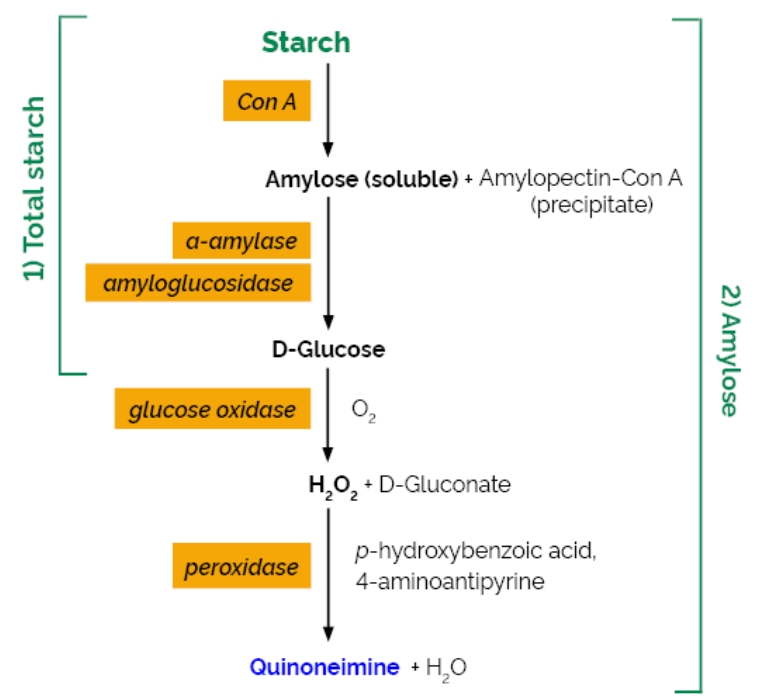- 背景資料
刀豆素A(刀豆蛋白A)(Concanavalin A ,簡稱Con A)屬於植物凝集素(Lectin)的其中一種,在特定的條件下,刀豆素A可與支鏈多醣(branched polysaccharides)非還原端上的α-D-glucopyranosyl和α-D-mannopyranosyl結合,並產生會沉澱的複合物。
➡️支鏈澱粉 (Amylopectin) 具有(α-1,6)醣苷鍵形成的支鏈,故會與刀豆素A產生沉澱複合物。
➡️直鏈澱粉(Amylose)只有(α-1,4)醣苷鍵形成的主鏈,故不會與刀豆素A產生反應。
- 操作流程(ASSAY PROCEDURE)
A. Starch Pre-treatment
1. Accurately weigh starch or flour sample (20-25 mg to the nearest 0.1 mg) into a 10 mL screw capped Kimax® sample tube. Record the sample weight to the nearest 0.1 mg.
NOTE: Include a reference sample with each batch. Duplicates of all samples are recommended.
2. Add 1 mL of DMSO to the tube while gently stirring at low speed on a vortex mixer. Cap the tube and heat the tube contents in a boiling water bath until the sample is completely dispersed (approx. 1 min). Ensure that no gelatinous lumps of starch are remaining.
3. Vigorously mix the contents of the sealed tube at high speed on a vortex mixer, return the tube to the boiling water bath and heat it for a further 15 min, with intermittent high-speed stirring on a vortex mixer.
4. Store the tube at room temperature for approx. 5 min and add 2 mL of 95% (v/v) ethanol with continuous stirring on a vortex mixer. Add a further 4 mL of ethanol, cap the tube and invert to mix. A starch precipitate will form. Allow the tube to stand for 15 min (or overnight if desired).
5. Centrifuge the tubes at 2,000 g for 5 min, discard the supernatant and drain the tubes on tissue paper for 10 min. Ensure that all of the ethanol has drained. Use the pellet in the subsequent amylose and starch determinations.
6. Add 2 mL of DMSO (with gentle vortex mixing) to the starch pellet. Place the tube in a boiling water bath for 15 min and mix occasionally. Ensure that there are no gelatinous lumps.
7. While removing the tube from the boiling water bath, immediately add 4 mL of Con A Solvent (working concentration) (see page 4) while vigorously mixing the tube contents. Quantitatively transfer the tube contents (by repeated washing with the Con A solvent) to a 25 mL volumetric flask. Dilute to 25 mL volume with Con A solvent (working concentration). This is Solution A. If necessary, filter this solution through Whatman® No. 1 filter paper (this step will be necessary for whole flour samples).
NOTE: This solution should be analysed within 2 h.
B. Con A Precipitation of Amylopectin and Determination of Amylose
1. Transfer 1.0 mL of Solution A to a 2.0 mL Eppendorf® microfuge tube. Add 0.50 mL of Con A solution (page 2, solution 1), cap the tube and gently mix by repeated inversion. Avoid frothing of the sample.
2. Allow the tube to stand for 1 h at room temperature. Centrifuge at 14,000 g for 10 min in a microfuge at room temperature.
NOTE:
NOTE-1. Samples in Con A Solvent (i.e. Solution A as described in Section A above) cannot be left for extended periods because the amylose will tend to retrograde and precipitate.
NOTE-2. The time required for effective Con A precipitation of the amylopectin (Step B1 above) is 1 h at room temperature. However, these solutions should not be left for longer than 2 h as the amylose will tend to retrograde.
NOTE-3. In this procedure, pre-treatment of the samples with ethanol has the added advantage of removing any soluble sugars in the sample that would otherwise interfere with the assay.
3. Transfer 1 mL of the supernatant to a 15 mL centrifuge tube. Add 3 mL of 100 mM sodium acetate buffer, pH 4.5. This reduces the pH to ~ 5. Mix the contents, lightly stopper (with a marble) and heat in a boiling water bath for 5 min to denature the Con A.
4. Place the tube in a water bath at 40°C and allow it to equilibrate for 5 min. Add 0.1 mL of amyloglucosidase/α-amylase enzyme mixture (page 2; solution 2) and incubate at 40°C for 30 min. Centrifuge the tube at 2,000 g for 5 min.
5. To 1.0 mL aliquots of the supernatant add 4 mL of GOPOD Reagent. Incubate at 40°C for 20 min. Incubate the Reagent Blank and the D-Glucose Controls concurrently.
NOTE: The Reagent Blank is prepared by adding 1.0 mL of 100 mM sodium acetate buffer (Buffer 1; page 4) to 4.0 mL of GOPOD Reagent and incubating at 40°C for 20 min. D-Glucose Controls (duplicate) comprise 0.1 mL of D-glucose standard solution (1 mg/mL), 0.9 mL of 100 mM sodium acetate buffer and 4.0 mL of GOPOD Reagent. This value is not used in the calculation, however we suggest that it is performed to ensure that there are no problems with this part of the assay.
6. Read the absorbance of each sample and the D-glucose controls at 510 nm against the reagent blank.
C. Determination of Total Starch
1. Mix 0.5 mL of Solution A with 4 mL of 100 mM sodium acetate buffer, pH 4.5.
2. Add 0.1 mL of amyloglucosidase/α-amylase enzyme mixture (page 2; solution 2) and incubate the mixture at 40°C for 10 min.
3. Transfer 1.0 mL aliquots (in duplicate) of this solution to glass test tubes, add 4 mL of GOPOD Reagent and mix well. Incubate at 40°C for 20 min. This incubation should be performed concurrently with the samples and standards from Section B above.
商品特色
商品規格
- 商品規格(100個檢測反應)
Bottle 1:
Freeze dried Con A.
Store below -10°C. See individual label for expiry date.
Bottle 2:
Amyloglucosidase (2 mL) [200 U on p-nitrophenyl β-maltoside
(i.e. 3,300 U on starch at pH 4.5 at 40°C)] plus fungal α-amylase (500 U on Ceralpha Reagent at pH 5.0 and 40°C).
Store at 4°C. See individual label for expiry date.
Bottle 3:
GOPOD Reagent Buffer.
Buffer (50 mL, pH 7.4), p-hydroxybenzoic acid and sodium azide (0.09% w/v).
Store at 4°C. See individual label for expiry date.
Bottle 4:
GOPOD Reagent Enzymes.
Glucose oxidase plus peroxidase and 4aminoantipyrine. Freeze- dried powder.
Store below -10°C. See individual label for expiry date.
Bottle 5:
D-Glucose standard solution (5 mL, 1.0 mg/mL) in 0.2% (w/v) benzoic acid.
Store sealed at room temperature. See individual label for expiry date.
Bottle 6:
Starch reference sample (with specified content of amylose).
Store sealed at room temperature. See individual label for expiry date.


